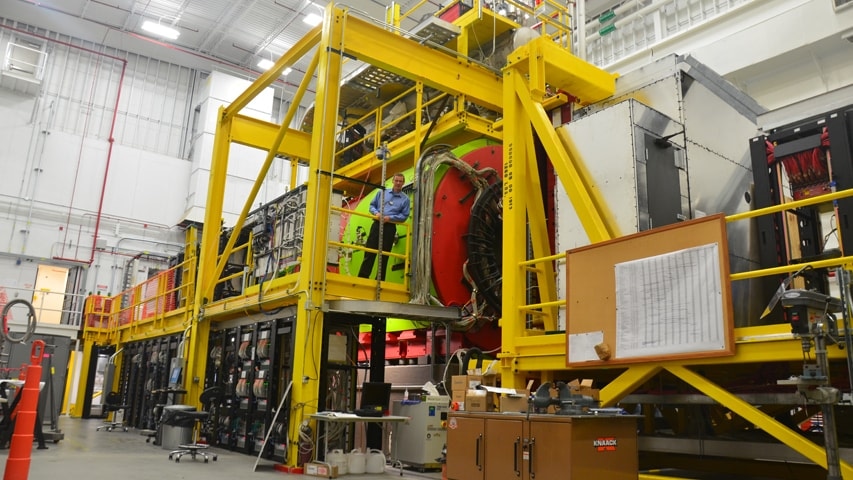May 11 2017
First results from upgraded Continuous Electron Beam Accelerator Facility at Jefferson Lab further GlueX experiment's quest to find exotic mesons
By Jocelyn Duffy
 At the J-Lab Continuous Electron Beam Accelerator Facility, Curtis Meyer stands on the GlueX platform. (Credit: Carnegie Mellon University)
At the J-Lab Continuous Electron Beam Accelerator Facility, Curtis Meyer stands on the GlueX platform. (Credit: Carnegie Mellon University)
Scientists are one step closer to understanding the strong force that binds quarks together forever.
Researchers working with the Continuous Electron Beam Accelerator Facility (CEBAF) at the U.S. Department of Energy's Jefferson National Accelerator Facility (J-Lab) have published their first scientific results since the accelerator's energy level was increased from six billion electron volts (GeV) to 12 billion GeV.
The upgrade was commissioned to usher in the next generation of physics experiments that will allow scientists to see smaller bits of matter than have ever been seen before.
The first publication from the upgraded CEBAF was published by the Gluonic Excitation Project (GlueX) in the April issue of Physical Review C.
Carnegie Mellon University Professor of Physics Curtis Meyer leads the GlueX experiment and is the experiment's spokesperson. He has been involved in the experiment since its inception nearly 20 years ago.
"It is really exciting to see all of our hard work start to pay off in published physics results. While our first publication is a huge milestone, it more importantly opens the door to many more publications in the coming years," Meyer said.
GlueX is hoping to use the CEBAF to produce exotic hybrid mesons, a subatomic particle made up of quarks that have been theorized but never captured experimentally. By producing a hybrid meson, researchers hope to be able to tease apart information about gluons - the particle that holds together the quarks in the meson. Hybrid mesons are of particular interest to the research group because they exist in an excited state. Understanding this state could reveal information about how subatomic particles are built and why quarks are never found alone.
In this new paper, the GlueX team describes how they produced two ordinary mesons, the neutral pion and eta. While creating these two particles is fairly simple for an accelerator of the CEBAF's magnitude, what was interesting to the researchers is that they were able to show that the linear polarization of the accelerator's photon beam can provide enough information about how the meson was formed. They can use that information to narrow down theories about how the mesons were produced.
"This result is both scientifically interesting, as it can put strong constraints on models of how these mesons are produced, and technically important as it demonstrates the ability of GlueX to use linear polarized photons to study meson production - something that most of our research program is based upon," Meyer said.
The research team plans to continue to analyze the data the accelerator has produced since it was commissioned a year ago, and they will begin to collect new data this fall.